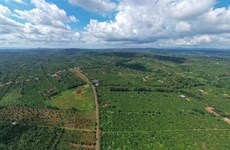Rubber exports bounce to record level on high demand
The quality of the country's natural rubber exports must improve in
order to be competitive in the global market, which has high demand for
the product, experts said at a conference organised by the Vietnam
Rubber Association in HCM City on May 12.
The quality of the country's natural rubber exports must improve in
order to be competitive in the global market, which has high demand for
the product, experts said at a conference organised by the Vietnam
Rubber Association in HCM City on May 12.
Despite many difficulties due to the global economic downturn, rubber exports last year reached a record high of 2.38 billion USD with 782,200 tonnes of rubber exported, said Tran Thi Thuy Hoa, VRA's General Secretary.
The figure represented an increase of 6.9 percent in volume and 94.7 percent in value, she said.
In the first four months of the year, about 204,000 tonnes of rubber was exported earning 897 million USD, up 31.3 percent in volume against the same period last year.
The average export price of rubber in the period surged by 1,751 USD a tonne over the same period to 4,391 USD per tonne.
According to the International Rubber Study Group (IRSG), demand for natural rubber is expected to increase by 4.6 percent this year to around 11.15 million tonnes due to the strong development of global auto industry.
Supply in the world market was projected to increase by 7.4 percent to 10.97 million tonnes, still lower than demand, IRSG said.
Natural rubber export prices therefore would remain high this year, Hoa said.
However, unstable rubber quality and too much reliance on the Chinese market were lowering the competitiveness of the rubber industry, she said.
Le Quang Trung, VRA's chairman, said the export price of Vietnamese natural rubber was lower than that of Malaysia , Thailand and Indonesia because importers blamed the inconsistent quality of Vietnamese products.
The country had created regulations to control the quality of latex but this applied mostly to large State enterprises, Hoa said.
She said Vietnam must order all companies involved in the rubber industry to apply a quality management system to improve rubber quality.
Currently, exports to China account for as much as 60-70 percent of the country's total rubber exports, mostly via the border trade.
This means that the country's rubber exports will be adversely affected when there is a fall in demand or there are changes in its border trade policy.
Rubber exporting firms should find new export markets to reduce the risks of depending too much on one market, Hoa said.
The sector should focus more on building brands for Vietnamese natural rubber to increase value for latex, said Dinh Ngoc Dam, director of Da Nang Rubber Joint Stock Company.
Although it was the world's fourth largest exporter of natural rubber after Thailand , Indonesia and Malaysia , Vietnam 's natural rubber brand was not highly appreciated in the world market, he said.
The country last year had 740,000ha of rubber plantations, an increase of 62,300ha over 2009, ranking fifth in the world in rubber cultivation area after Thailand , Indonesia , Malaysia and India .
Vietnam expects to export between 760,000 and 780,000 tonnes of rubber worth 2.7-3 billion USD this year./.
Despite many difficulties due to the global economic downturn, rubber exports last year reached a record high of 2.38 billion USD with 782,200 tonnes of rubber exported, said Tran Thi Thuy Hoa, VRA's General Secretary.
The figure represented an increase of 6.9 percent in volume and 94.7 percent in value, she said.
In the first four months of the year, about 204,000 tonnes of rubber was exported earning 897 million USD, up 31.3 percent in volume against the same period last year.
The average export price of rubber in the period surged by 1,751 USD a tonne over the same period to 4,391 USD per tonne.
According to the International Rubber Study Group (IRSG), demand for natural rubber is expected to increase by 4.6 percent this year to around 11.15 million tonnes due to the strong development of global auto industry.
Supply in the world market was projected to increase by 7.4 percent to 10.97 million tonnes, still lower than demand, IRSG said.
Natural rubber export prices therefore would remain high this year, Hoa said.
However, unstable rubber quality and too much reliance on the Chinese market were lowering the competitiveness of the rubber industry, she said.
Le Quang Trung, VRA's chairman, said the export price of Vietnamese natural rubber was lower than that of Malaysia , Thailand and Indonesia because importers blamed the inconsistent quality of Vietnamese products.
The country had created regulations to control the quality of latex but this applied mostly to large State enterprises, Hoa said.
She said Vietnam must order all companies involved in the rubber industry to apply a quality management system to improve rubber quality.
Currently, exports to China account for as much as 60-70 percent of the country's total rubber exports, mostly via the border trade.
This means that the country's rubber exports will be adversely affected when there is a fall in demand or there are changes in its border trade policy.
Rubber exporting firms should find new export markets to reduce the risks of depending too much on one market, Hoa said.
The sector should focus more on building brands for Vietnamese natural rubber to increase value for latex, said Dinh Ngoc Dam, director of Da Nang Rubber Joint Stock Company.
Although it was the world's fourth largest exporter of natural rubber after Thailand , Indonesia and Malaysia , Vietnam 's natural rubber brand was not highly appreciated in the world market, he said.
The country last year had 740,000ha of rubber plantations, an increase of 62,300ha over 2009, ranking fifth in the world in rubber cultivation area after Thailand , Indonesia , Malaysia and India .
Vietnam expects to export between 760,000 and 780,000 tonnes of rubber worth 2.7-3 billion USD this year./.













